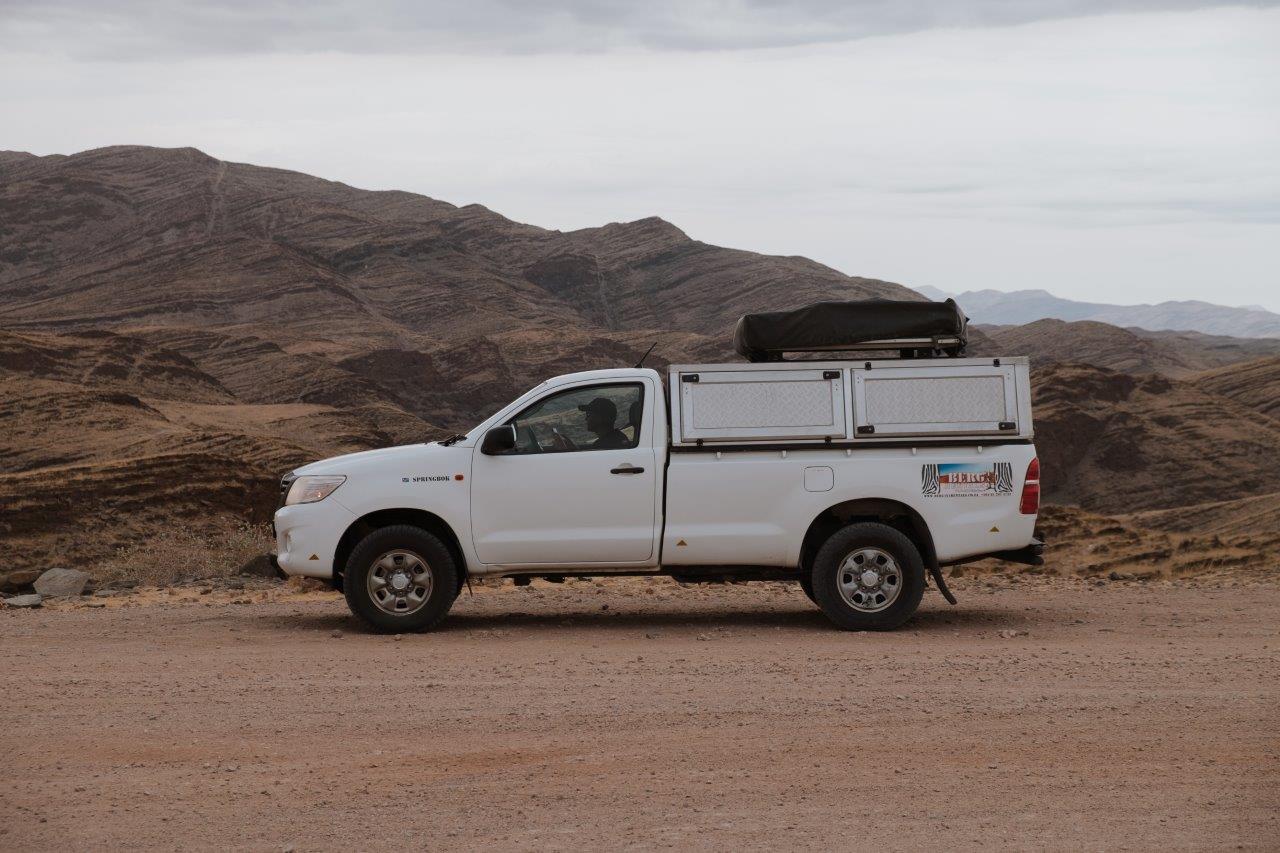
To finish off the greatest year I’ve ever had, I’ve undertaken one final massive adventure. For the last two months of the year, I visited nine countries across southern Africa, my first time on the continent and one vastly different to anything I’ve ever encountered before.
I flew from Salzburg all the way down to Cape Town via Istanbul with a friend of mine from my city, preparing ourselves for a three-week journey through six countries, after which I would continue solo for another month on the continent. Our trip began with a week based in Cape Town, a gem of a city situated right on the southern tip of Africa. We landed on a beautiful Saturday morning, picked up our rental car and spent the rest of the day getting acquainted with the city and exploring many of its highlights.
After our exceptional week spent in Cape Town, one of my now-favourite cities in the world, we dropped off our rental car at before spending the night sleeping on benches in Cape Town airport. From there, we took an early morning flight in a tiny airplane up to Windhoek in Namibia where we picked up our rental 4x4 truck with a roof tent and headed into the city, anticipation at an all time high for the adventure we were about to undertake.
We spent a few hours at a cafe in town - and within those first few hours, our car window was forced open and a suitcase stolen from inside. We got the entire thing on security camera footage (the city is full of them) and spent the bulk of our day filing a police report. It was a horribly unsettling feeling to start a trip on and while the suitcase and about a third of the belongings were recovered four days later and delivered to us in Johannesburg, we wanted out of Windhoek and so as soon as we could, we drove out of the city, four hours deep into the Namibian desert where we camped under the stars, trying to feel at peace and whole.
Although I'd love to say that the trip got easier, I want to be honest and say that it was a challenging two weeks traversing the intense and wild landscapes of southern Africa. Having said that - we absolutely loved this trip. It was wild, challenging and eye-opening but it was also rewarding, raw and strengthening. If you've got some solid travel experience under your belt and are looking for an adventure that will push you to the far edges of your comfort zone requiring a large dose of resilience and perserverance to battle through, a roadtrip through southern Africa might be just the thing.
Our 2 Week Roadtrip Route through Southern Africa
We spent sixteen days traversing six countries across southern Africa. We fuelled up seventeen times to drive a total of 5736 kilometres between Windhoek Airport in Namibia and Johannesburg Airport in South Africa. We stayed at ten campsites, one luxury lodge, one hotel and two AirBnbs. We crossed seven land borders, had one suitcase stolen, both got sunburnt, both got sick, had three flat tyres, suffered through countless other car issues, perservered through three horrific storms, got stuck in sand dunes and managed to do the entire thing for less than €4500 for both of us (not including any flights). Aside from all the struggles and challenges, we also visited four national parks where we spotted every wild animal on our wishlist, witnessed some of the most surreal and everchanging landscapes we'd ever seen, took thousands of photographs, hiked epic tracks in the wilderness, saw the stars every night and came out of the trip stronger and more resilient than ever before.
Our journey saw us starting in Windhoek, then venturing out for six days across Namibia, where we witnessed extraordinary places, deep in the desert and thousands of years old. The incredible sand dunes of Sossusvlei took our breath away; the majestic spikes of Spitzkoppe rising out of the flat red neverending horizon were awe-inspiring; the rock carvings at Twyfelfontein are the best preserved in southern Africa; and Etosha National Park was supreme and by far our favourite visited on our cross-Africa trip.
From Namibia, we turned eastward and completed our first African land border crossing into Botswana. During our four days in Botswana, we visited two exceptional game reserves - the revered Okavango Delta, a wet river delta teeming with life, before entering Chobe National Park, home to a huge elephant population (and terrible roads).
From Botswana we continued east across the continent, making the long drive from Chobe National Park towards Victoria Falls, a famous spot in northern Zimbabwe and right on the border with Zambia. From Victoria Falls, I walked across the land border into Zambia and spent a few hours exploring Victoria Falls on the Zambia side but then walked back that same afternoon. We finished our time in Zimbabwe with a long drive southward to the South African border, stopping over in the Matobo Hills for a night.
From Zimbabwe, we re-entered South Africa on the opposite side of the country to spend a few days witnessing wild animals in the world famous Kruger National Park and driving the naturally stunning Panorama Route.
Our roadtrip finished with a quick one-night visit to Eswatini, a small kingdom entirely landlocked by South Africa and home to the largest rock in Africa, and the second largest in the world only after Uluru in Australia.

Our approximate route across southern Africa
Reflections on the Roadtrip
One thing I reflected on as we spent more than a hundred hours in the car across those six nefarious countries was that I was perfectly content to sit idly with nothing to do for hours upon hours. I was reminded how, as a child, one always requires such constant stimulation, and I remembered how, in preparation for long roadtrips with my parents, I would pack my “car box”, a flat pink-lidded clear box in which I would load games, trinkets, books and toys to keep me amused for how many hours we were to be on the go. Now, a good playlist and the view of the open road is more than enough for adult me, content to watch the world go by without any sense or need to ask “are we there yet?”. I am satisfied with merely placing my body in rest mode, sitting relatively comfortably in a seat, being motored forward at anywhere between 20 and 120km per hour. It is a far cry to say the roads we traveled were comfortable – we tackled potholes, sandy roads, torrential rainstorms, gravel roads, wild animal crossings and the like – but I never once found myself on the road wishing I was anywhere else.
I've never had my driver's license and for someone to willingly ask me to join them on a cross-country roadtrip and bearing the brunt of the stressful driving situations speaks volumes. I did my best to contribute equally, playing roadtrip tunes, navigating us across the continent, taking photographs as we drove, providing snacks and water and any other supplies needed and making the breakfasts, lunches and dinners. We shared in the logistics, the pragmatism and the practicalities, considering driving lengths and times and routes, contrasted with the creativity, the inspiration and the ideas for new places to go and the continued and endless support to keep us going even in the toughest of conditions. Together, side by side, we were able to face adverse situations with the knowledge that we had each other to rely on and that, no matter what, we'd be able to not only work through it but conquer it.
On this trip, I discovered something I think I've known all my life but consciously reaffirmed it about myself. I am fundamentally an optimist.
We found ourselves these weeks in some of the worst situations we’ve ever been. At one point, my stress levels were so high they actually caused me to become quite seriously ill, even losing my vision at one point to what I can only resemble as purple clouds and what I imagine it would feel like to be on psychedelics. However, not once during these moments, or any of the lesser emotionally wrought ones, did I ever find myself losing hope or regretting anything. Perhaps then it is not pure optimism but with a strong dash of reason, sensibility and practically thrown in the mix that permitted me to step back, assess the situation and consider a way out of it. I never lost hope, I never lost joy and even, on the worst roads in the worst weather in a terrible vehicle in a corrupt country, I focused on the bravery and resilience I was building up instead of the negativity and anger that could bubble up just as easily. In the end, the trip was two weeks long and I didn’t want to spend the bulk of those two weeks wishing they were over, expecting more things to go wrong (which they inevitably continued to do) but instead believing that each challenge we overcame was building up our battery of resilience to better equip us for the next challenge that would come, if any had to come at all. At the end of the day, it wasn’t me vs him, it was me and him vs the situation and the more we were able to join forces with a grin and say, “heck we bit off a bit of a big adventure here but we’re going to make the most of it,” then the better off we were. Mental soundness and strength can go a long way in producing the best outcomes for shitty situations.
When we tried to come up with some words to describe the trip, we said challenging, rewarding, strengthening, eye-opening and wild. While it has been so much more than that - as you can read in the many posts I've written about our journey - but it summarizes the most intense few weeks we've undertaken, tackled with perserverance, resilience, courage, determination and a whole lot of strength. It was a wild, wild adventure and I am utterly grateful to have been on it and to get to share our journey.
A Word on Safety in Southern Africa
I'm no safety expert and I'm being honest when I'm saying that a trip to Africa requires a lot more safety-awareness than you might typically expect of say, Europe. It's just how it is. If you take sensible precautions when traveling around, you should be fine.
We took lots of precautions and still ended up in crap situations - stolen luggage, corrupt borders, bad road conditions.
If you must travel with valuables e.g. camera, laptop, always carry them with you. Leave nothing in your car unattended anywhere, and even when driving, ensure all your belongings are hidden out of sight - smash and grabs are common at red lights.
Never travel at night - stay in a safe, fenced, locked accommodation (campsite, AirBnb, etc.) with security and CCTV before sunrise and after sunset. The roads are poor and filled with potholes and likely to have wild animal crossings, both of which you can't see at night, and the roads are very rarely lit. Gangs also populate the streets after dark look for unsuspecting victims.
Ensure you have all your travel vaccinations up to date, including yellow fever (it's not required, but they may ask for it at the border). Carry ibuprofen, throat lozenges, allergy medication, diarrhea medication and any other pills you may find useful. Malaria is common; I strongly suggest taking daily malaria tablets - you start a day before your trip begins and finish a week after your trip ends.

A typical sign you'd see outside a grocery store
Tips for Southern Africa
There are many languages spoken across the countries, however English is widely spoken and understood across them all.
The weather can get extremely hot in the summer months but prepare for all sorts of weather. We had intense rainstorms as well as intense heat and sun. Bring cool, thin clothing and plenty of layers to accommodate for the changing temperatures.
Each country uses its own currency, and you're going to need to make sure you've got cash to use in each of them. Many places only accept cash but a surprising number (such as all gas stations, except those in Zimbabwe) do accept international MasterCard or Visa. They also typically accept most other currencies - we often used Rand, NAD, Euro, Pula and USD cash in interchangebaly across all countries and all were readily accepted.
Get a local SIM card in each country to ensure you have data while you're roaming the desert and also local calling in case you need to contact your accommodations or encounter roadside issues.
All of southern Africa drives on the left side (opposite to Europe, same as the UK). You'll find a massive variety of roads - the great "A" roads are paved and usually well-maintained (save for a pothole or two), "B" roads are lesser quality paved roads, "C" roads are good quality gravel roads and then "D" roads are bad quality gravel or sand roads. And "F"... well, don't go there. They're basically dirt tracks.
Renting a 4x4 for your Roadtrip
The only way to succesfully do a roadtrip across southern Africa is in a 4x4. The roads just simply aren't suitable for any lesser vehicle. You can choose to hire drivers in various places, such as national parks, which could cut down on your need to self-drive a lot. We did self-plan and self-drive our entire trip in a rented 4x4 truck with a roof tent. This was vital for tackling sand dunes, pot holes and other adverse situations.
There are a number of companies who offer rentals of this type in the region as it's such a common way to travel. We rented from Berg Rentals who were certainly the cheapest available, but this meant the car came with a number issues and we didn't feel their vehicle was as good as it should have been...! We saw a lot of Britz vehicles on the road and heard good things from fellow travelers.
Most of these companies expect you to do big trips and allow for drop-off and pick-up in different places; we picked up our car at the Windhoek Airport in Namibia and dropped it off 5736km later at the Johannesburg Airport in South Africa two weeks later.
Doing our roadtrip this way enabled us to save a lot of money on accommodations as we slept in the roof tent (most nights) on top of our car and it was a brilliant way to be close to nature and out in the wild as we traveled.

Our 4x4 with a roof tent
How much did our 2 week roadtrip through Southern Africa cost?
We managed - with a good budget and with camping in our roof tent and cooking for ourselves along the way - to keep our entire roadtrip to under €4500 total for two people (not including our flights from Europe, plus the flight from Cape Town up to Windhoek). For what we managed to see and do and for how far we traveled, plus including buffer costs to cover unexpected expenses such as replacement clothes, car repairs and a night in a luxury lodge, we are very proud of this figure.
Approximately, here's how our spendings can be broken down, for a total of €4,440.82:
- Accommodation (ten campsites, one luxury lodge, one hotel, two AirBnbs) = €1,099.64
- Car costs (gas, road tolls, rental car, parking) = €2,404.76
- Food & drinks = €311.18
- Customs & visas = €183.93
- Entertainment (entry fees, mokoro trip in Botswana) = €400.63
- Car repairs (tyres) = €40.68
Detailed itinerary for 2 week roadtrip through Southern Africa
Below, I have outlined a day-by-day itinerary for exactly what we did as we crossed six countries across southern Africa including driving distances, accommodation, things to do and links to read more about each place.
Day 1 - Windhoek to Solitaire
Namibia
After we landed at the Windhoek International Airport and picked up our rental 4x4 car, we headed into Windhoek. Given our experience in this city, I would use it as a pit stop only to get fuel, food (SuperSpar is great) and supplies for your roadtrip but one person should stay with the car at all times (particularly if your car is obviously a rental e.g. has rental stickers indicating luggage likely inside). Once you're sorted, head out of town as soon as you can.
DRIVE: Drive the 250km out west through the desert to the funky little town of Solitaire.
STAY: Solitaire campsite
DO: On day 1, we were so preoccupied with luggage being stolen and Windhoek police, we didn't have time for much else. The best thing to do on day 1 anyway while you're getting acquainted with Namibia is to soak in the surrounding views as you drive deep into the desert.
READ MORE: Our Journey to Sossusvlei

Road to Solitaire

Solitaire campsite
Day 2 - Sossusvlei to Swakopmund
Namibia
For our first full day in Namibia, we visited the iconic Sossusvlei desert, home to some of Namibia's most well-known landscapes and the vast red sand dunes stretching far into the horizons. Note that to visit Sossusvlei, you'll definitely need a 4x4 (as with the entire roadtrip) given the sandy roads you need to conquer - if you don't feel comfortable doing this drive, you can join a guided tour with an experienced local driver.
DRIVE: From Solitaire, drive just over 140km to Sossuvlei through Sesriem (where you'll pay an entrance fee). At Sossusvlei, the final stretch to park for Deadvlei is cmpletely sandy (and we got stuck at one point and had to be rescued by one of the local drivers). After Sossuvlei, we drove back to Solitaire and then headed about 200km north to Swakopmund, crossing the Tropic of Capricon along the way.
STAY: Tiger Reef campsite in Swakopmund
DO: Hike into Deadvlei, the incredible white clay pan at Sossuvlei with the famous dead camel thorn trees. Take in the expansive red sand desert around you and try to spot some wildlife (ostrich and oryx are common here). Take a photo with the Tropic of Capricorn sign.
READ MORE: Our Journey to Sossusvlei

Driving towards Sesriem
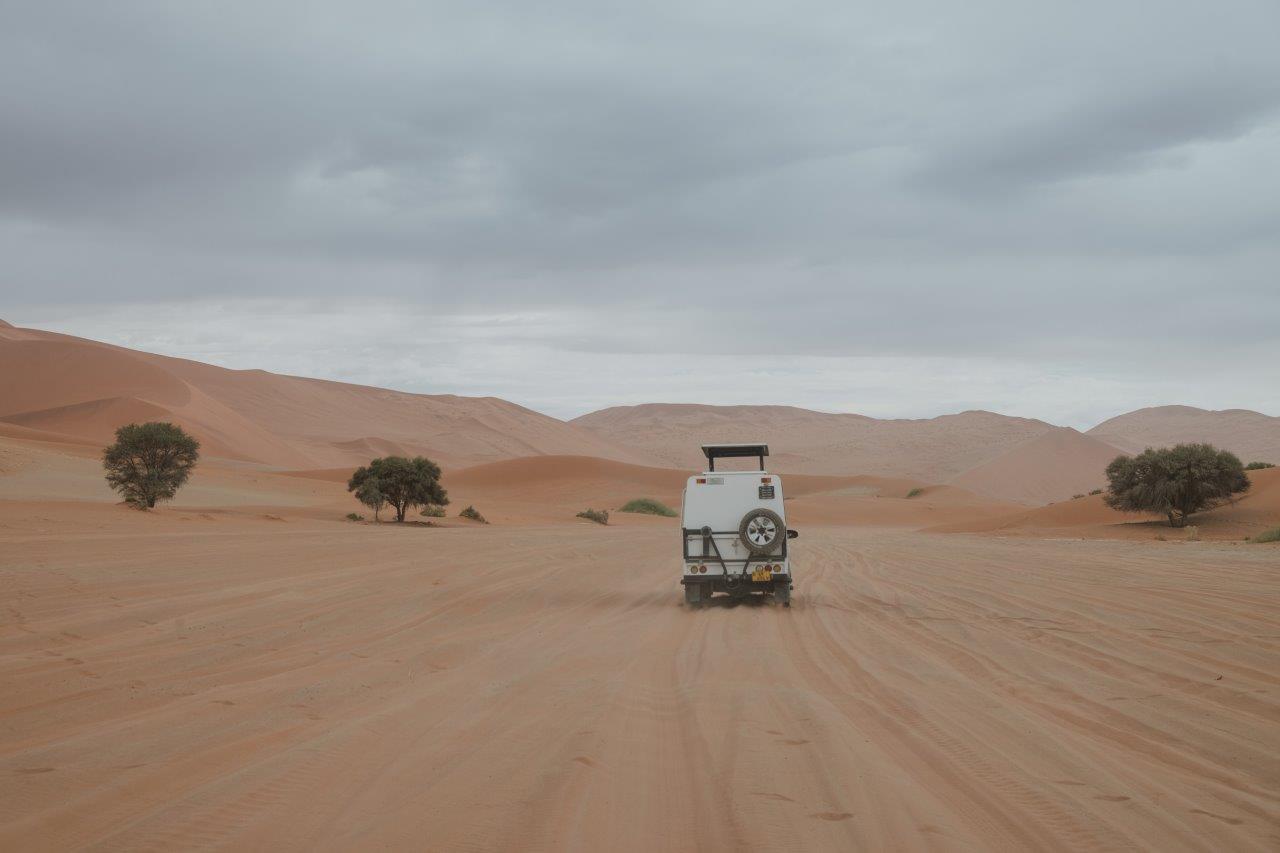
Roads of Sossusvlei

Deadvlei

Tropic of Capricorn sign
Day 3 - Swakopmund to Spitzkoppe to Twyfelfontein
Namibia
From Swakopmund, we left the African coast behind for the rest of the trip and headed inland towards Spitzkoppe, a collection of bald granite peaks, thought to be more than 120 million years old. The most symbolic of them all is the pointed triangular mountain rising more than 1700 metres high. The stunning red rocks make for an otherworldly landscape to explore. End your day in Twyfeltonein, a haven in the north and home to world famous rock carvings.
DRIVE: From Swakopmund, drive 160km on mostly easy paved roads to the poignant peaks of Spitzkoppe already visibly bursting out of the horizon from many miles away. Spitzkoppe does have a campsite if you'd like to stay here (which we recommend - you can camp in and amongst the beautiful red rocks under the stars). From Spitzkoppe, drive the gravel road nearly 240km north to Twyfelfontein (the roads get particularly bad for about 50km near the end and the final 30km are on beautiful paved roads - a relief).
STAY: Twyfelfontein campsite
DO: Hike through the incredible red rocks of Spitzkoppe and spot the bushmen art thought to be over 2000 years old. Hike above the camp in Twyfelfontein for amazing landscapes.
READ MORE: A Guide to Spitzkoppe and Visiting the Rock Art of Twyfelfontein

Spitzkoppe

Our guide showing us the bushmen cave art painted in red oryx blood

Hiking in Spitzkoppe

Views of Twyfelfontein
Day 4 - Twyfelfontein to Etosha National Park
Namibia
We spent day 4 exploring the incredible rock carvings of Twyfelfontein, a UNESCO site and said to be the best preserved in southern Africa. After Twyfelfontein we drove even further north and entered our first national park of the trip, Etosha, which would ultimately end up being our favourite of all the ones we visited across the continent.
DRIVE: The rock carvings are at a site about 8km along a gravel road leading off the main road from the Twyfelfontein Campsite. From there, we drove just over 340km northeast to Okaukuejo and the starting point of our adventure through Etosha.
STAY: Okaukuejo rest camp in Etosha National Park
DO: Visit the beautifully preserved rock carvings of Twyfelfontein, thought to be 2000-6000 years old. Spot wildlife inside the exceptional Etosha National Park - enter at Okaukuejo on the west side and stop at Ombika Waterhole and Okondeka Waterhole. Watch sunset and hopefully spot more wild animals at the waterhole at the Okaukuejo campsite.
READ MORE: Visiting the Rock Art of Twyfelfontein and A Guide to Etosha National Park

The famous rock carvings of Twyfelfontein

Zebra near Okondeka Waterhole

Ombika Waterhole in Etosha
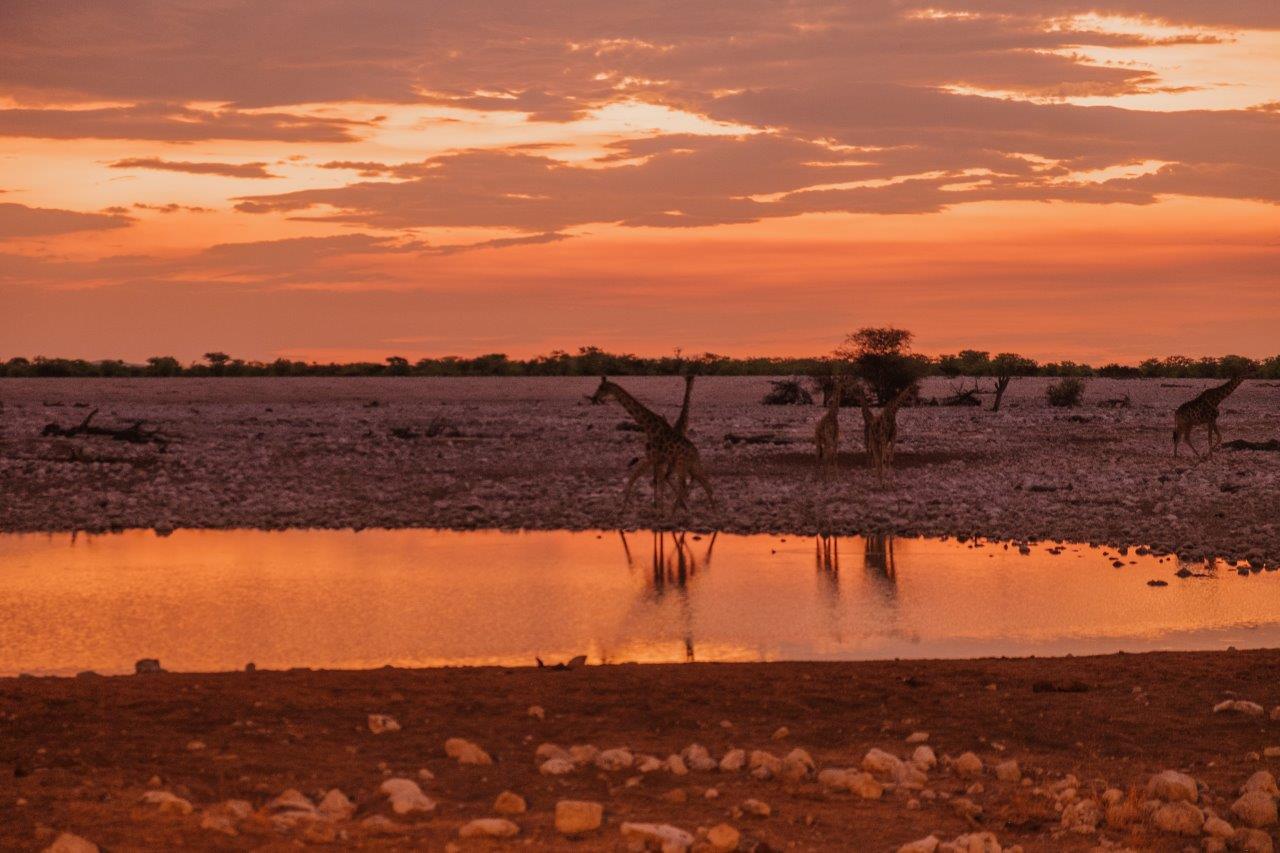
Giraffe at the Okaukuejo Waterhole
Day 5 - Etosha National Park
Namibia
Our fifth day on the road was dedicated entirely to exploring the magnificent Etosha National Park. We were completely entranced by this national park. Within a few minutes we had animal sightings of all kinds across the plains. Not only were we lucky enough to spot all the most-seen animals such as giraffe, zebra, springbok, ostriches, wildebeest, baboons and many birds, but we also got to see two rhino and even saw a leopard, hiding high up in the branches of a tree just before the exit at Namutoni.
DRIVE: Enter the gates at Okaukeujo and make the 134km drive east across the park across the southern part of the Etosha Pan to reach Namutoni, the exit gate on the far side of the park. The roads are gravel but very well-maintained and we suggest taking all the detours as this is where you'll have the best chance of spotting animals.
STAY: Goba rest camp in Gobabis (we stayed here on our way to Botswana as the road through Gobabis is one of the two routes - you can also try Roy's Rest Camp which is along the other route to Botswana)
DO: Spot as many incredible wildlife as possible during your self-drive safari through Etosha National Park.
READ MORE: A Guide to Etosha National Park
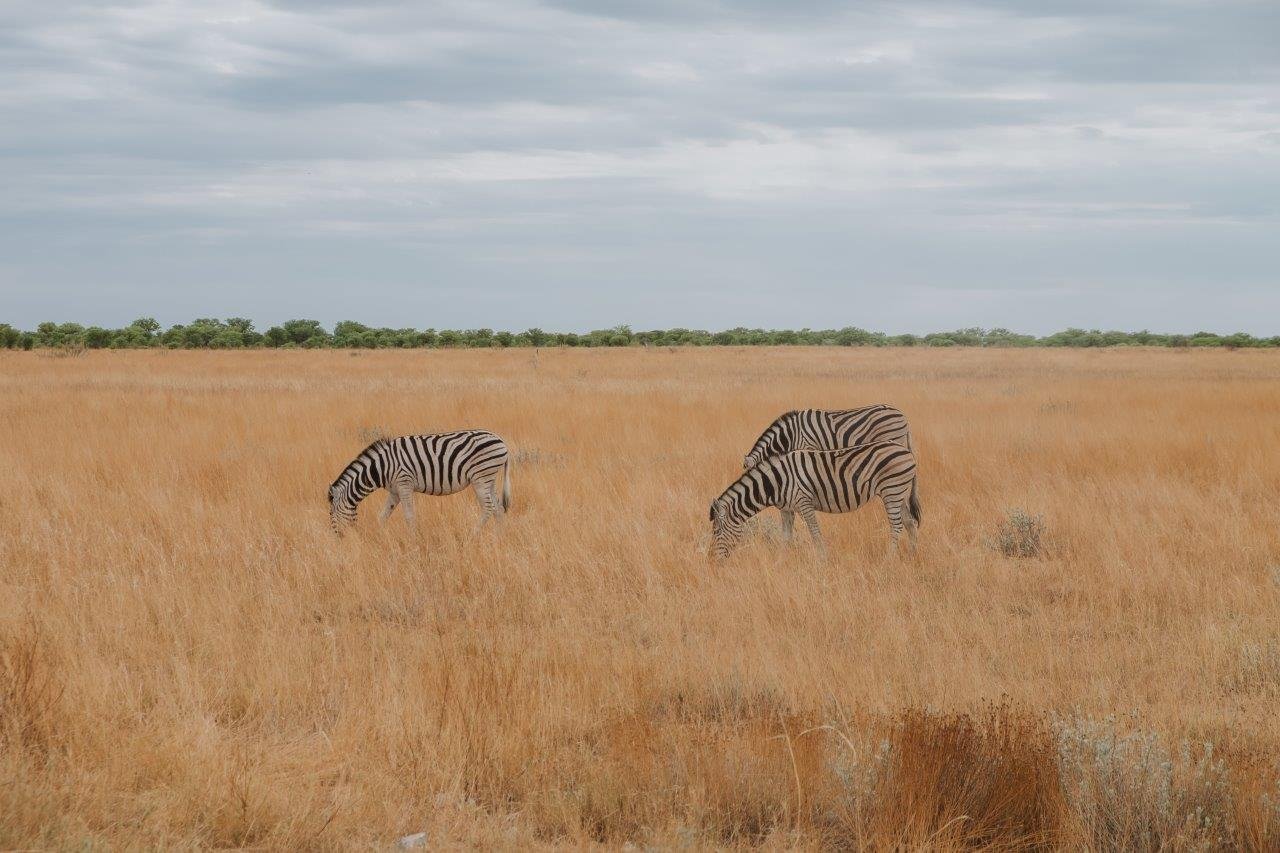
Zebra
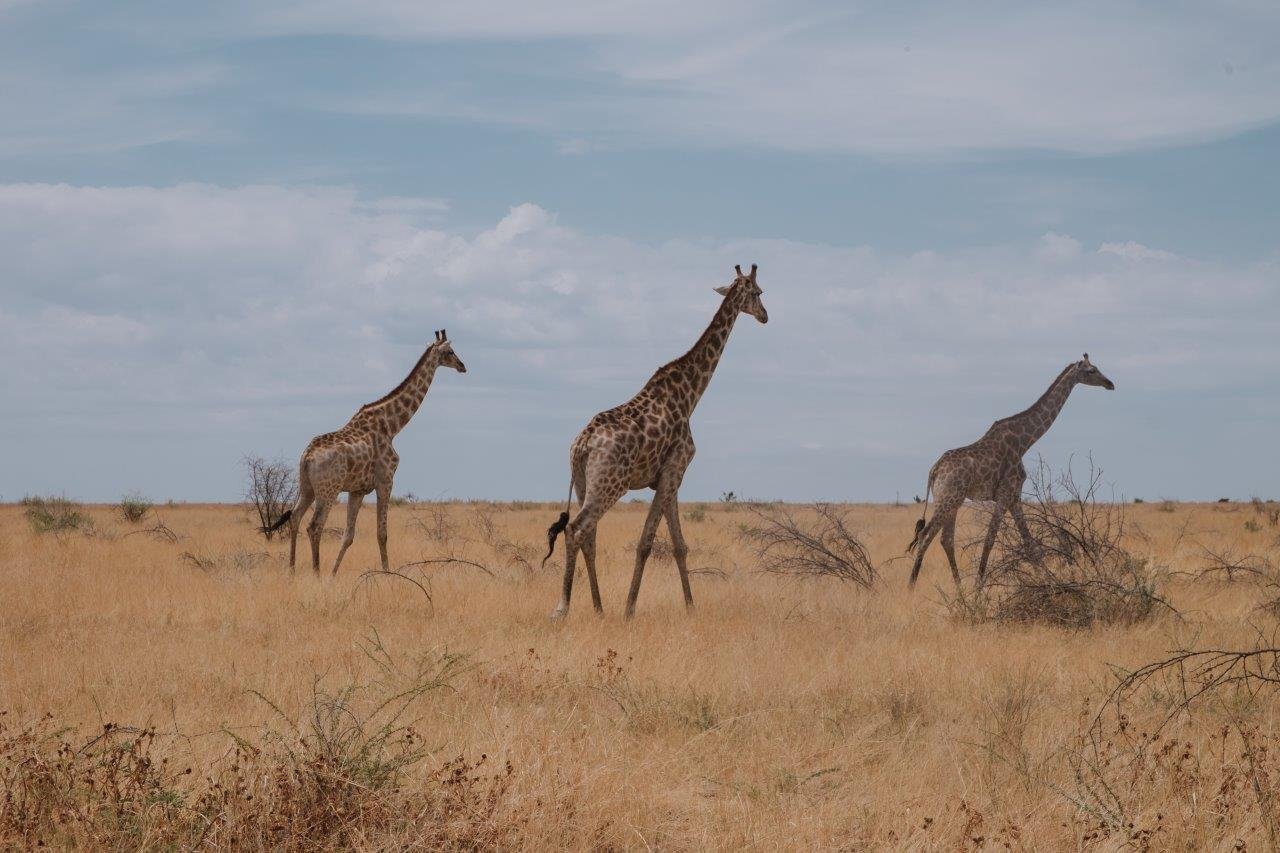
Giraffe

A Jana!

Springbox at a waterhole
Day 6 - Namibia to Botswana
Our final day in Namibia saw us heading eastward to cross the border into Botswana. Depending on how you're planning to visit Botswana, if you're coming by road you're very likely to be driving across the border from neighbouring Namibia. The last place we visited in Namibia was Etosha National Park giving us two options to head eastward. We chose the southern route below through Gobabis as the roads are better quality (crucial on an African roadtrip!). This is also the same road you'd take if heading east directly from Windhoek.
After we crossed the border at Buitepos from Namibia, we drove to Ghanzi where we picked up fuel, food and a Botswana SIM card. We then headed north through Maun to enter the Okavango Delta, a revered and magical nature reserve, teeming with wildlife that call the shallow riverbeds home.
DRIVE: From Buitepos, drive the 600km north through Maun to the heart of the Okavango Delta. The road between the Botswana border and Maun is really well paved and easy to drive. After Maun, we encountered the worst roads of our entire roadtrip. This was made exponentially tougher by probably one of the most severe rainstorms we've ever witnessed which we had to drive straight through. The road is completley full of pot holes, sand and dirt, and large accumulated pools of water. The rainstorm turned the road to a swamp.
STAY: Mankwe Lodge and Campsite
DO: Take in Botswana for the first time. Spot wild animals as you enter the Okavango after Maun - we got lucky with elephant and giraffe sightings!
READ MORE: Visiting the Okavango Delta

Looking over the waterhole at Mankwe

Mankwe Reserve Camp
Day 7 - Mankwe to Mbudi
Botswana
We rose early in Mankwe to enjoy the sumptious surroundings of the Mankwe Lodge which we had opted for after our rough day on the road the night before so we didn't have to camp. The breakfast was a delight, as was the service and kindess of the staff. We had to deal with a broken fridge and some other car issues, which were becoming a daily occurrence for us, but other than that, we tackled the sandy roads with grit and determination to make it to our next stop through the delta. It was here that we were able to partake in a traditional mokoro ride to see the Okavango Delta from the water - peaceful and sublime, a welcome respite from the stress we'd been under.
DRIVE: From Mankwe, drive just 50km to Mbudi, a much more rustic camp spot in the delta. The roads are sandy - in good weather, it'll still take you about two hours to complete the short drive.
STAY: Mbudi Camp where you can camp next to hippos!
DO: Spot wild animals as you drive through the delta. Take a ride on a traditional mokoro along the shallow rivers of the Okavango Delta to spot hippos, animals, birds and plants.
READ MORE: Visiting the Okavango Delta

Driving through the Okavango Delta

Hippos in the pool next to our campsite

Mbudi campsite
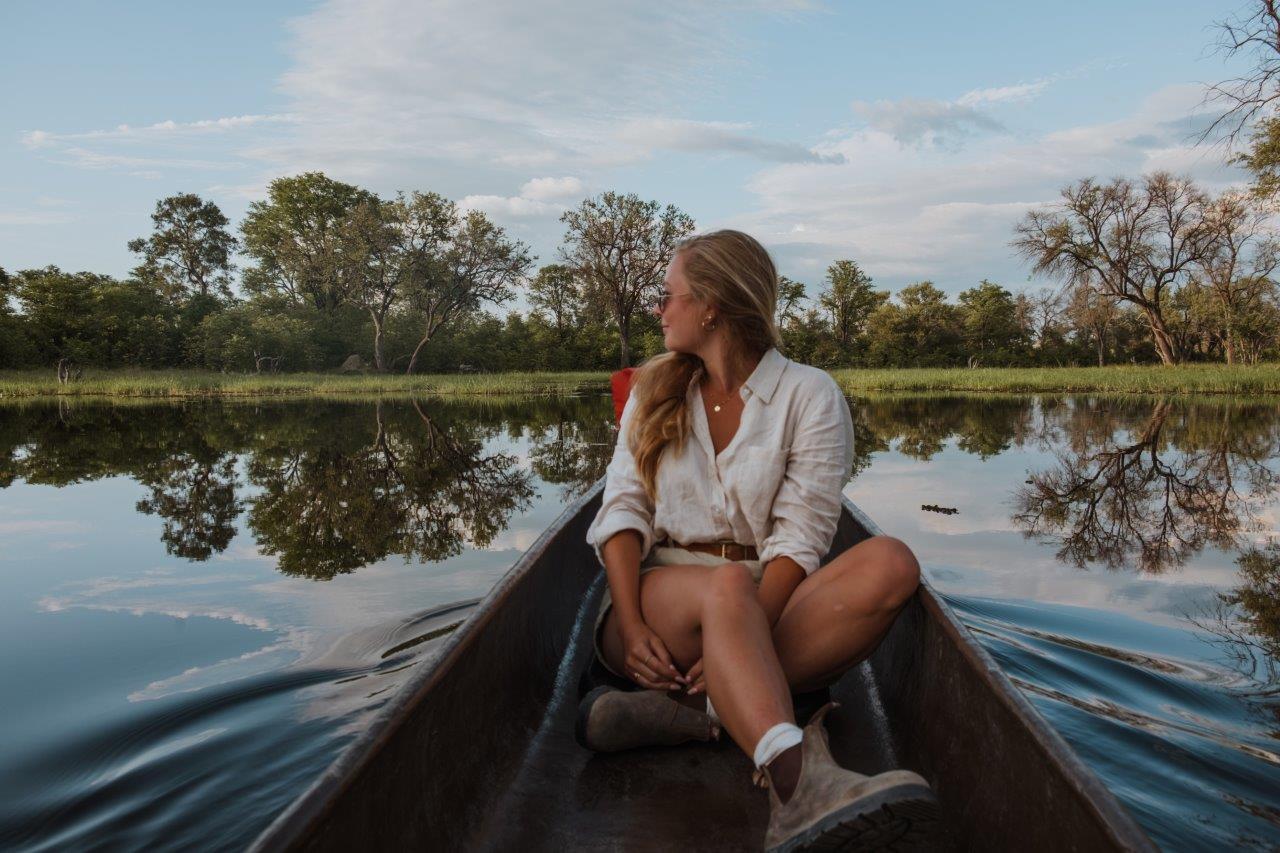
Floating down the Okavango Delta in a mokoro
Day 8 - Mbudi to Savuti
Botswana
We focused our third day in Botswana on a game drive, heading northward through the Okavango Delta and entering through the south gate of Chobe National Park to see what we could find. Admittedly we didn't see as much game in Chobe National Park as we had seen in the exceptional Etosha National Park in Namibia, but were still thrilled to spot plenty of elephants, giraffe, zebra and ostriches along the bumpy, sandy roads.
DRIVE: From Mbudi, head north into Chobe National Park. Chobe, like all of the other national parks we visited in southern Africa, can be self-driven with your own vehicle at your own pace or, given how terrible the roads are, you can also opt to hire a driver and go on safari with someone who knows the roads expertly. The drive from where we camped at Mbudi in the Okavango to the Savuti camp in the heart of Chobe was quite terrible and took us a good three hours to conquer even though it's less than 100km. However, it was still an experience I wouldn't have wanted to miss out on - there's nothing like driving along a maddeningly potholed and sandy road bumping around in a 4x4 and spotting a pack of elephants lumbering out of the bush ahead of you. Sure, it was insane at times, but I think in both a good way and a not-so-good way and it was the sum total of the experience that made it memorable and rewarding.
STAY: Savuti Campsite
DO: Spot wild animals as you drive through the delta. Have lunch at the designated rest spot and maybe get lucky to share the space with an elephant or two!
READ MORE: A Guide to Chobe National Park
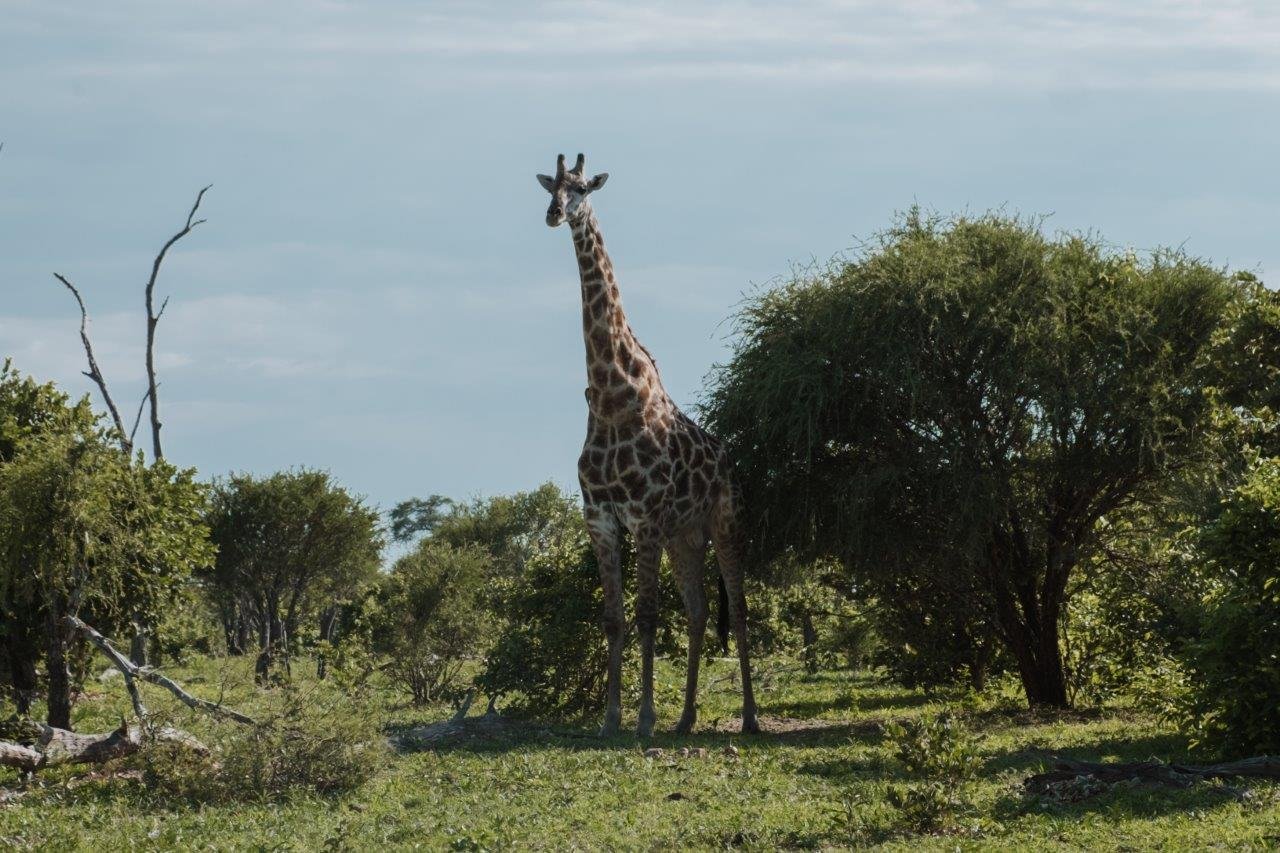
Giraffe

Elephant crossing

Ostriches - including babies!

A camp visitor
Day 9 - Botswana to Zimbabwe
We left Chobe National Park in Botswana and drove due east straight across the country and towards the Zimbabwe border at Kazungula, just beyond the town of Kasane. The 250km was easy and on wonderful paved roads, a massive change after three days spent on terrible roads in the national parks of Botswana. In fact, I think it was partially due to the relief of being back on safe roads and the fact that my body had been on high-adrenaline fight or flight mode for so many days that within an hour of getting back onto the paved roads, I got quite severly ill. During the border crossing from Botswana to Zimbabwe as we were filling out our paperwork for our visa I temporarily lost my vision with the entire world going completely purple. I spent the next four days quite sick and weak which we reckon was entirely stress-based; it was too soon for malaria and COVID-19 tests came back negative.
DRIVE: From Savuti, leave Chobe National Park and sign out at the exit gate. If you are continuing into Zimbabwe, drive the 250km towards Victoria Falls, right at the very northern tip of the country bordering Zambia.
STAY: we stayed at a wonderful AirBnb in Victoria Falls
DO: Spot wild animals as you drive through the national park.
READ MORE: A Guide to Chobe National Park and How to Visit Victoria Falls


Day 10 - Victoria Falls
Zimbabwe & Zambia
Victoria Falls can be visited from both Zimbabwe and Zambia. I recommend basing yourself in Victoria Falls in Zimbabwe and doing your exploring from there. You can then walk across the land border over the bridge into Zambia for a few hours to explore the falls from the other side.
Victoria Falls is a UNESCO World Heritage Site shared between these two countries. The falls are basically a gigantic sheet of water that stretches nearly 1.7km across the countries on both sides o the Zambezi River. The official site has all the up to date entrance information. We had to pay $30 USD on the Zimbabwe side to enter, and I paid another $20 USD on the Zambia side.
STAY: we stayed at a wonderful AirBnb in Victoria Falls
DO: Walk all around the incredible Victoria Falls on both the Zimbabwe and Zambia sides.
READ MORE: How to Visit Victoria Falls

Victoria Falls from Zimbabwe

Victoria Falls in Zambia
Day 11 - Victoria Falls to Matobo Hills
Zimbabwe
After Victoria Falls, we made the long drive southward across all of Zimbabwe. We broke up the drive with an overnight stay in the UNESCO Matobo National Park but unfortunately a combination of driving exhaustion and no cash to pay the entry fee means we missed out on seeing the Matobo Hills themselves.
DRIVE: From Victoria Falls, we drove more than 480km into Matobo Hills. Note that you'll need to pay quite a few Zimbabwean road tolls (I think we paid five) which are $2 USD each. The tolls don't seem to pay for much given that even the "A" roads in Zimbabwe are full of pot holes and slow going... Also note that gas stations in Zimbabwe take USD cash only, no cards.
STAY: Big Cave Campsite in the Matobo Hills
DO: Definitely make time to visit the renowned Matobo Hills and explore this beautiful world heritage site.
Day 12 - Matobo Hills to Messina
Zimbabwe to South Africa
We left the Matobo Hills behind for another long drive through the rest of Zimbabwe and back into our beloved South Africa. The border was time-consuming but relatively straightforward, minus the frustration of the border officer not accepting our $10 USD bill because it had a tear in it (a bill we had collected in change just a few minutes earlier from the road toll office and that we then had to barter with someone outside to exchange it for 200 South African Rand with which we could pay our customs fee...).
DRIVE: From Matobo Hills, head toward the border crossing at Beitbridge and into South Africa. We spent the night just across the border in Messina spending the rest of the afternoon catching up on rest.
STAY: Old Mine Guesthouse in Messina
DO: Navigate the border crossing back into South Africa. Rest, after long days of driving.
Day 13 - Messina to Kruger National Park
South Africa
From Messina, we very excitedly turned eastward and drove across the northern part of South Africa towards the world famous Kruger National Park. Not only did we witness hundreds of wild animals during our days in Kruger, but we also watched eighteen giraffe all coupled up on a massive open plain before coming across all of the big predators: three buffalo, two lions and a cheetah. These animals are completely wild and we have zero say so on what they do or where they go, so every single sighting is a rare and lucky chance and somehow our stars aligned and we got them all. Feeling utterly privileged for moments like this.
DRIVE: Kruger National Park, like all the national parks we visited across southern Africa, can be visited with a guide or you can simply self-drive through the park, stopping whenever and wherever you may choose. We entered Kruger at the Pafuri Gate in the far north and spent three days / two nights driving south through the park.
STAY: We spent our first night at the delightful Tsendze Rustic Camp, which wasn't rustic in the slightest and provided a great kitchen and toilet facility. You book all your campsites on the Kruger website and plan your route out there.
DO: Go on a self-drive safari through Kruger National Park, spotting as many wild animals as possible.
READ MORE: A Guide to Kruger National Park

Driving into Kruger National Park

Elephant spotting
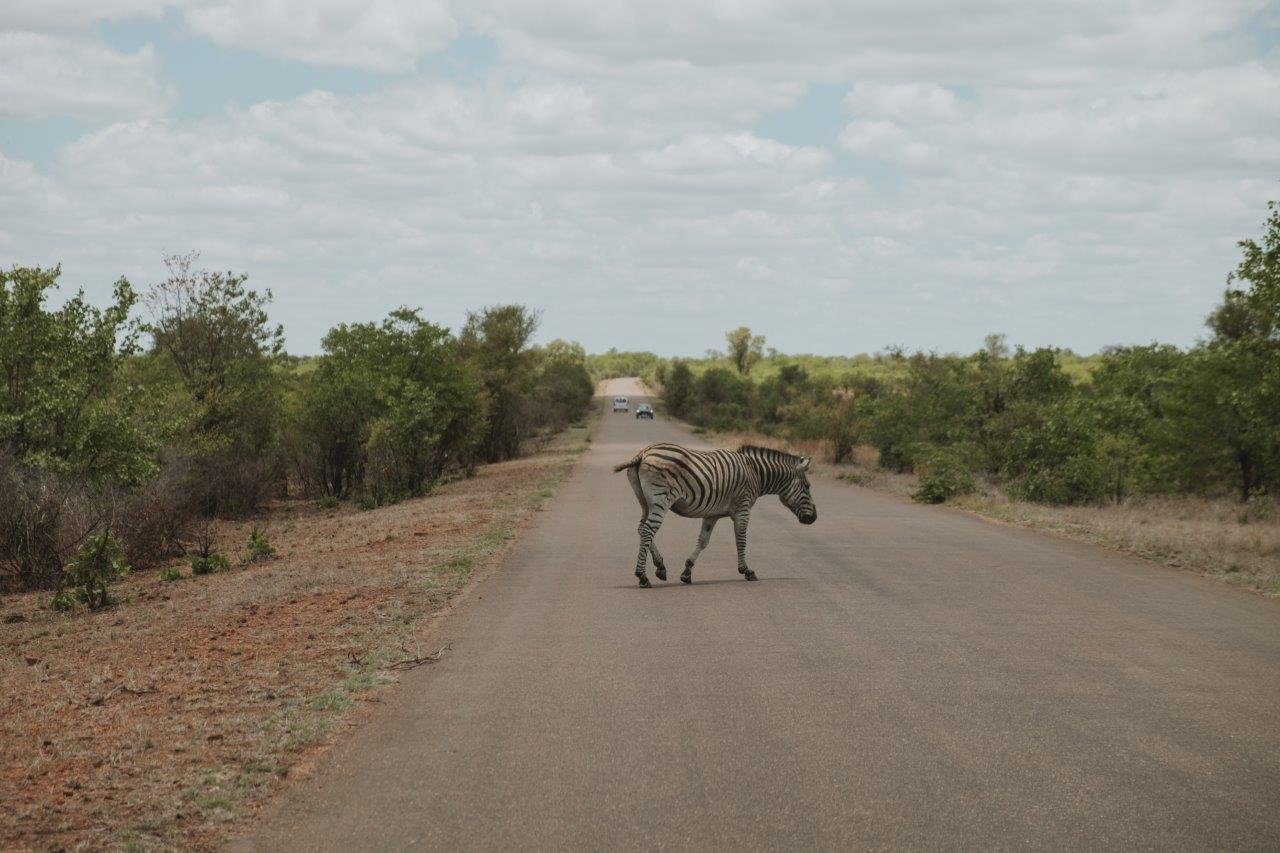
Zebra crossing
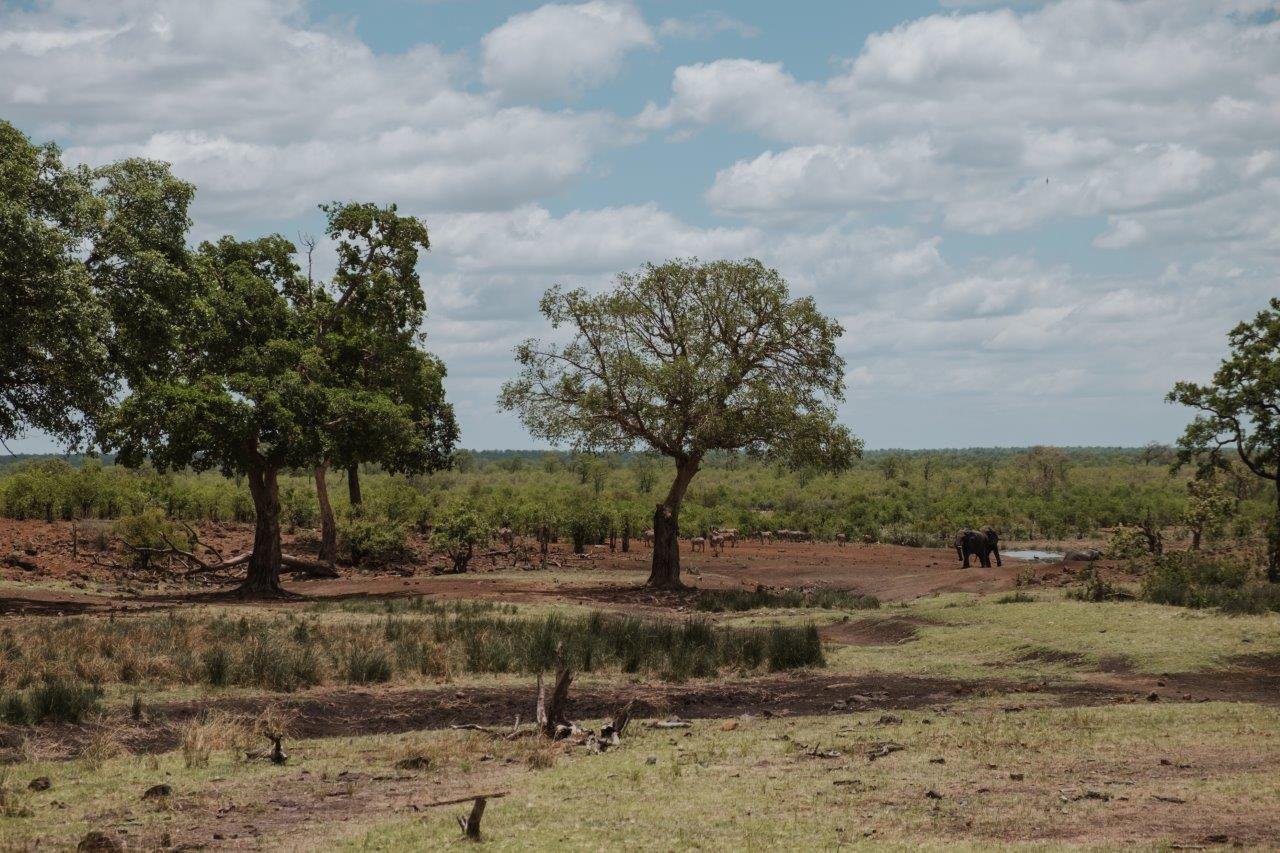
Another elephant in the beautiful Kruger landscapes
Day 14 - Kruger National Park
South Africa
Our second day in Kruger was dedicated purely to driving from north to south, self-driving and trying patiently to find as many animals as possible.
DRIVE: Whilst Kruger was certainly the most developed and best maintained national park we visited, we found the paved roads, while easy to drive, actually to be a detriment to animal viewing as the animals all avoided the areas or ran away as we approached in our car. We looked up the best bush routes to drive through the park (we highly recommend S39!), getting off the paved roads and back onto the gravel and, while they were bumpier to drive, that’s where the animals came out in full force.
STAY: We spent our second night at the Skukuza Camp which is the largest in the park and feels a bit more on the touristy/family-friendly side, complete with pools, spas and restaurants... You book all your campsites on the Kruger website and plan your route out there.
DO: Continue your self-drive safari through Kruger National Park, spotting as many wild animals as possible.
READ MORE: A Guide to Kruger National Park

Elephant crossing
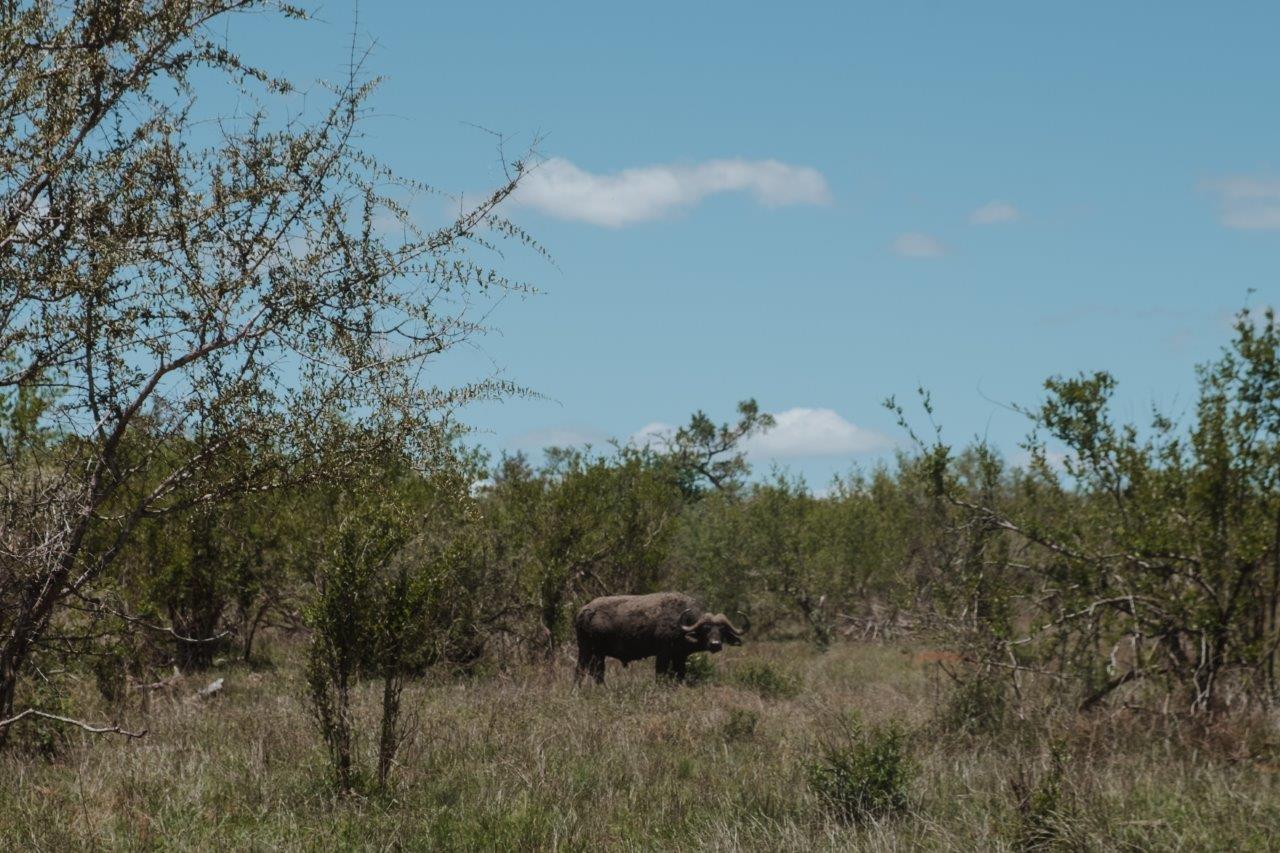
A buffalo, one of the most dangerous predators
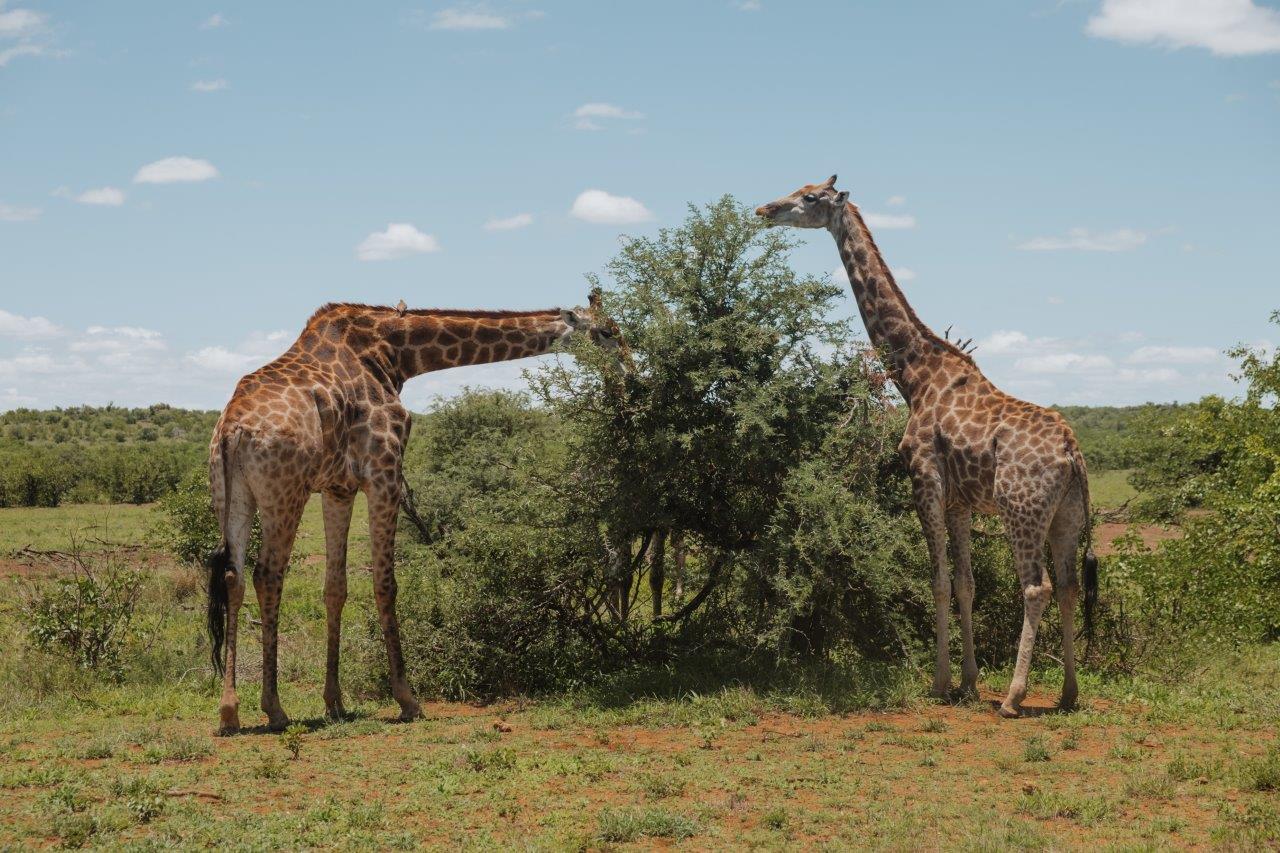
A plain full of griaffes

2 lions!! A major highlight
Day 15 - Kruger National Park to Eswatini
South Africa to Eswatini
We left the incredible Kruger National Park behind to make our way towards our final stop in South Africa: the revered Panorama Route, a 160km loop near Graskop connecting mountain passes, waterfalls, hikes, viewpoints and other incredible natural formations of the region. We only had a short time window with which to drive the route so picked three spots to stop at but found it to be one of the highlights of our entire roadtrip. From there, we drove southward to our sixth and final country of the roadtrip, the tiny little Eswatini, a nation completely landlocked by South Africa and offering breathtaking panoramic mountainous views.
DRIVE: From Kruger, we drove about 100km westward to begin our loop on the Panorama Route. From there, we headed the 260km southward to the Oshoek Border Post crossing into Eswatini. The capital of Eswatini is Mbabane and where we had our AirBnb for the night, so we entered at the closest border crossing. The border crossing between the two countries was a total breeze, perhaps one of the easiest of our trip. Maybe it was a combination of it being our sixth African land bordering crossing and we were pros by this point as well, but certainly it felt like there was no corruption and no strange expectations; we picked up our gate passes, got our immigration departure stamps, paid our customs fee, got our immigration entry stamps and then we were in Eswatini!
STAY: This incredible AirBnb in Mbabane, Eswatini, with views over Sibebe Rock
DO: Spot wild animals as you leave Kruger National Park. Awe in wonder at the views over Pinnacle Rock and from Wonder View on the Panorama Route. Hike to the bottom of Lisbon Falls, maybe one of the prettiest I've ever seen. Cross the border and take in the views of the mountainous nation of Eswatini.
READ MORE: A Guide to Kruger National Park and Driving the Panorama Route and 24 Hours in Eswatini
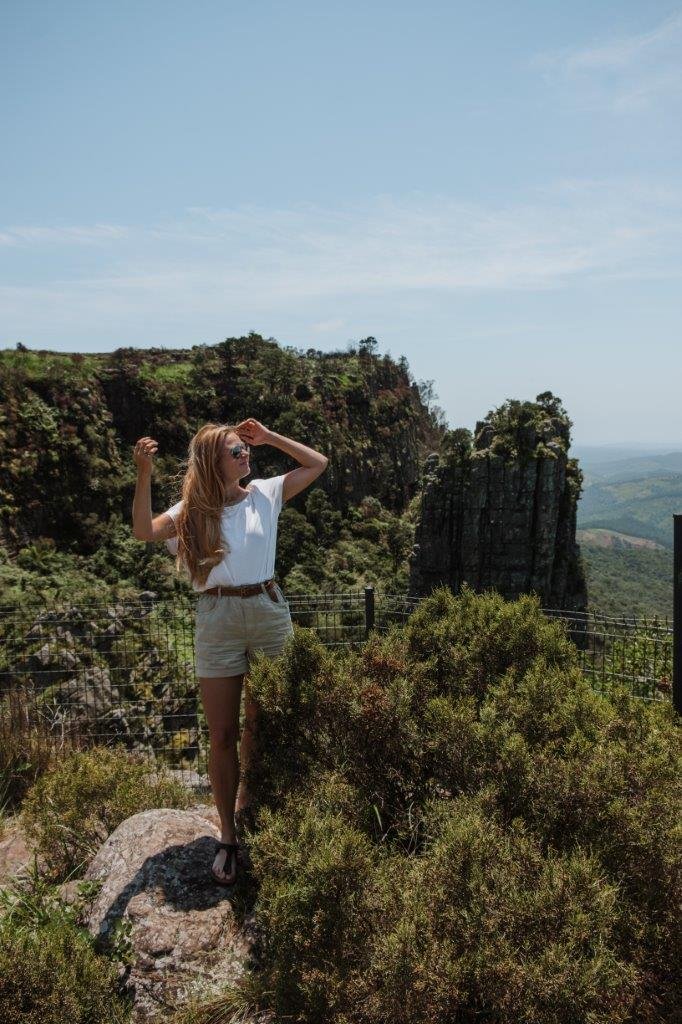
Pinnacle Rock on the Panorama Route
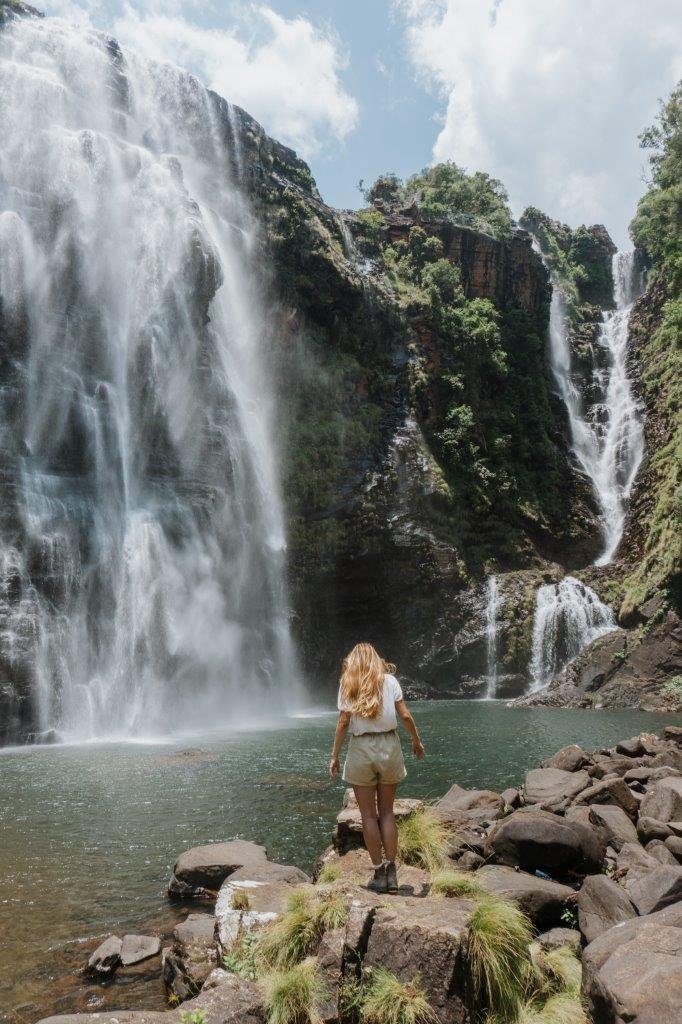
Lisbon Falls

The view of Eswatini from our AirBnb
Day 16 - Eswatini to Johannesburg
Eswatini to South Africa
And just like that, two weeks on the road came to an end and we woke up on our final day in Eswatini. Sibebe Rock in Eswatini is the largest rock in Africa and only the second largest in the world, after Uluru in Australia. And, perhaps while it isn't exactly the largest rock in the world, it does happen to be the world's largest granite dome. It's three billion years old and made of volcanic rock, reaching nearly 1500 metres tall and covering 165 square kilometres. It's BIG!
DRIVE: The best way to visit Sibebe Rock is to go hiking on it, something we would have dearly loved to but didn't have time for (we still had a border crossing back to South Africa and a 370km drive back to Johannesburg) but you should definitely do if you have a day for it! Instead, we drove a big chunk of the loop road that circles around the base of the rock and, even though the sky was overcast and moody, we thoroughly enjoyed the varying views of this gigantic ecological feature.
STAY: We woke up in this incredible AirBnb in Mbabane, Eswatini, with views over Sibebe Rock
DO: Hike Sibebe Rock!
READ MORE: 24 Hours in Eswatini

Roads of Eswatini

Sibebe Rock
And just like that, one of the most incredible, challenging, rewarding, wild and eye-opening adventures of my life came to an end. From then on it was time for me to face a solo month on the continent, beginning with a week in Johannesburg. So, the adventures continue...
PIN THIS POST TO REFER BACK TO LATER!
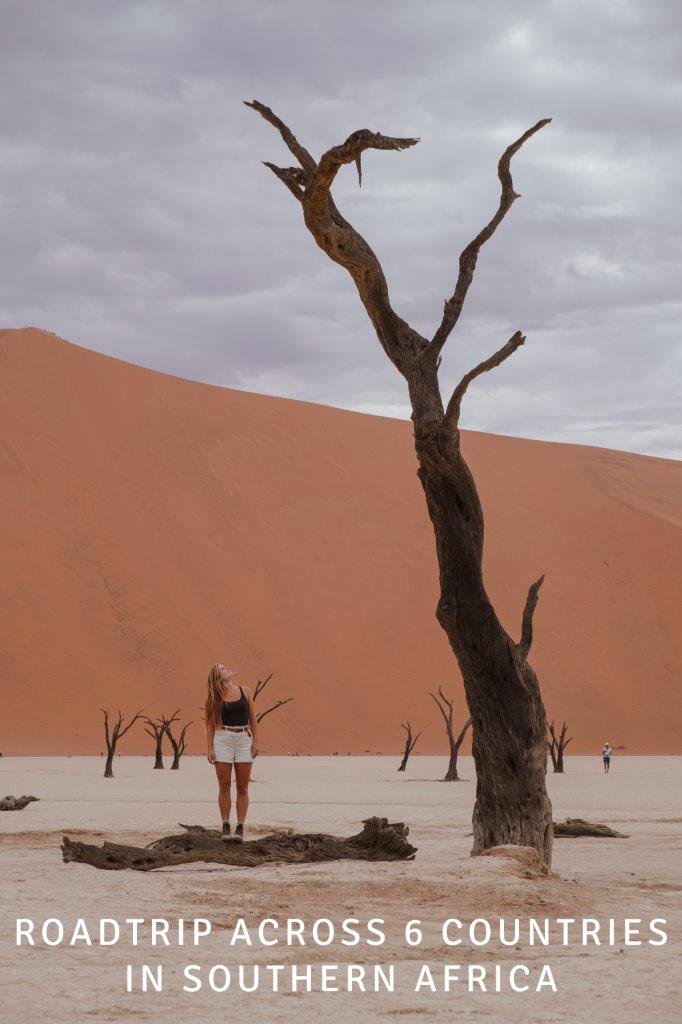

Hi! I’m Jana, a British-Dutch-Canadian with a dream of seeing every country in the world. I am a storyteller, photographer and adventurer passionate about documenting and sharing my travels.
